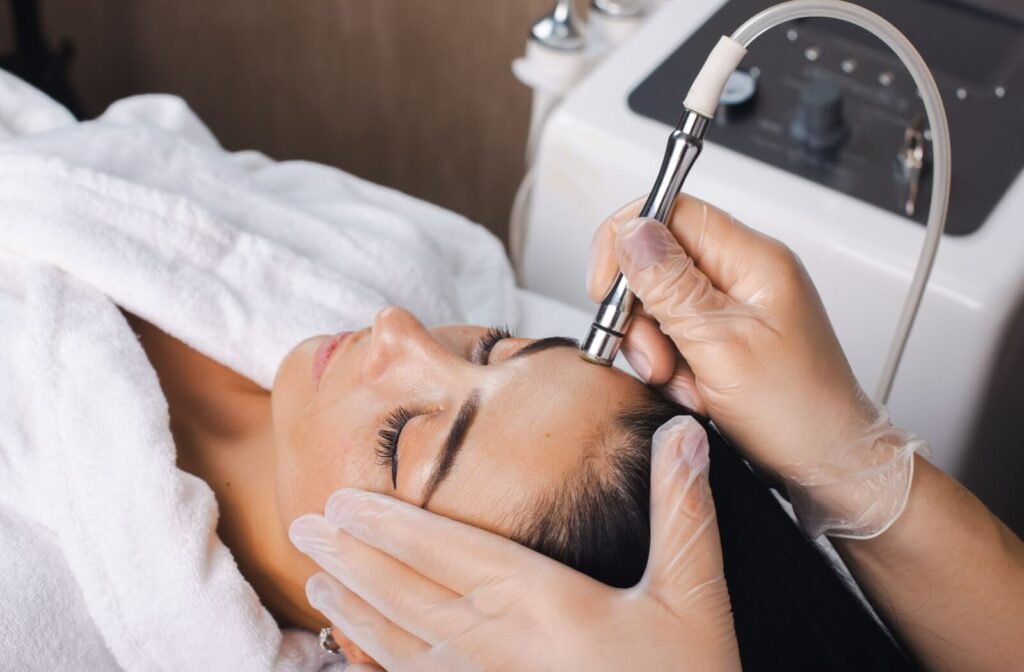‘Microabrasion’ is definitely a mouthful. But it’s really not as complex as it sounds. Microdermabrasion is a noninvasive treatment that gently removes the outermost layer of dead skin cells from your face.
When done correctly, this is a great way to support your skin, encouraging healing and regeneration during periods of acne-flare ups. However, acne type and severity matter.
If you have active, inflamed pimples in the area where you’re considering treatment, it’s better to wait until they heal. Microdermabrasion over active breakouts can spread bacteria and potentially cause scarring.
More on Microdermabrasion
Microdermabrasion essentially buffs away dead skin cells. It mechanically exfoliates your skin to reveal a smoother surface underneath, while stimulating your skin’s natural renewal process.
It sounds more intense than it is—the process is relatively gentle and seamless. Many patients see visible results after just one session. Besides, there’s virtually no downtime, so you can return to your daily routine immediately after treatment.
However, there’s one thing that we have to clarify right away: shaving your face with a facial razor is not the same as microdermabrasion. Facial shaving, (or dermaplaning), when done professionally, removes surface peach fuzz (vellus hair) and some dead skin cells, but it primarily focuses on hair removal.
On the other hand, microdermabrasion uses a device with a fine, abrasive tip to deeply exfoliate the skin and remove the top layer of dead skin cells. It also promotes cell turnover and can help improve issues like uneven texture, hyperpigmentation, and fine lines.
While shaving can temporarily make your skin feel smoother, microdermabrasion provides a deeper exfoliation and more targeted skin benefits, making it a more comprehensive treatment for skin renewal.
How Microdermabrasion Helps with Acne
Along with evening out your skin for a smoother look and feel, microdermabrasion done right can help address active breakouts. Here’s how:
Actively Unclogs Pores
One of the primary reasons why blemishes appear is because of pores that are clogged with dead skin cells, oil, and bacteria.
Microdermabrasion physically removes dead skin cells that can block your pores, making it easier for your skin to breathe and reducing the likelihood of new breakouts forming.
Reduces Acne Scarring
If you’ve dealt with acne for a while, you may have some scarring or uneven skin texture. Not all scars are the same; some are deeper than others.
Microdermabrasion can’t remove these marks, but it does help improve the appearance of mild scars. How? Because this physical process itself encourages skin cell turnover and promotes the growth of new, healthy skin cells.
Improves Product Absorption
Skincare products are a fantastic (and soothing) way to support and achieve healthier, more radiant skin. The trick is making sure these products are working to the best of their ability, which is where microdermabrasion comes in.
After a session, your skin is better able to absorb topical acne treatments like benzoyl peroxide or salicylic acid. This means your existing acne medications can work more effectively.
Stimulates Collagen Production
The gentle abrasion stimulates your skin’s healing response, which includes increased collagen production. This can help improve skin texture and reduce the appearance of fine lines that sometimes accompany acne-prone skin.

Acne That Responds Well to Microdermabrasion
While blemishes tend to be annoying, not every pimple is the same.
Acne comes in different types, and microdermabrasion is a treatment that works better on some flare-ups more than others:
- Comedonal Acne: Better known as blackheads and whiteheads. Microabrasion treatment can help clear out these blockages and prevent new ones from forming.
- Mild to Moderate Acne: For occasional breakouts, microdermabrasion is gentle enough for regular use but effective enough to make a noticeable difference.
- Acne Scars: While it won’t eliminate deep scars, microdermabrasion can significantly improve the appearance of surface-level scarring.
Your Microdermabrasion Session: What to Expect
Microdermabrasion is a relatively gentle and straightforward process. As with any new experience, knowing what you expect during your visit can help you feel more relaxed and at ease. The last thing we want is more stress, which does your skin (and you!) no favors.
After an initial consultation, we can move forward with your first session:
- The treatment typically takes 30 to 60 minutes, depending on the size of the area being treated. Your aesthetician will cleanse your skin thoroughly before beginning the procedure.
- During the treatment, you’ll feel a gentle scratching sensation as the device moves across your skin. Most people find this comfortable; some even describe it as feeling like a cat’s tongue licking their face.
- After the treatment, your skin might look slightly pink, similar to a mild sunburn. This is completely normal and usually fades within a few hours.
The frequency of these treatments varies from person to person. It all depends on your skin type, the severity of your acne, and how your skin responds.
We generally recommend sessions every 2–4 weeks for people with acne-prone skin. This gives your skin time to heal and regenerate between sessions while maintaining the benefits of regular exfoliation.
Caring for Your Skin Post Treatment
Though microdermabrasion is safe and relatively gentle, your skin might feel extra sensitive after your session. Here’s how you can support your skin:
- Never Skip Sun Protection: Wearing a broad-spectrum SPF 30 or higher is non-negotiable. Sun damage can worsen acne scarring and cause hyperpigmentation.
- Keep it Simple: For the first 24-48 hours after treatment, stick to gentle, fragrance-free skincare products. Avoid harsh exfoliants, retinoids, or strong acne medications that could irritate your newly treated skin.
- Stay Hydrated: Even oily, acne-prone skin needs moisture. Use a lightweight moisturizer to keep your skin hydrated without clogging pores, and drink plenty of water.
- Don’t Pick or Touch: Resist the urge to touch your face or pick at any flaking skin. Let your skin heal naturally to avoid infection or scarring.
Taking the Next Step in Skincare Journey
Microdermabrasion can be an effective tool in your fight against acne, but it’s not a miracle solution.
If you’re considering microdermabrasion to achieve radiant skin, the most important step is the initial consultation. So come visit our Bethel Vision Care team! We’ll take the time to evaluate your skin and discuss your treatment goals to find out if microdermabrasion is right for you.
Connect with our team to book an appointment and let us help you achieve your skincare goals.



